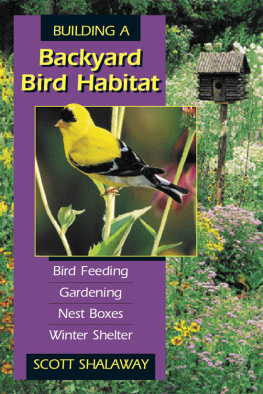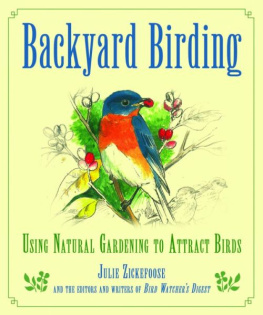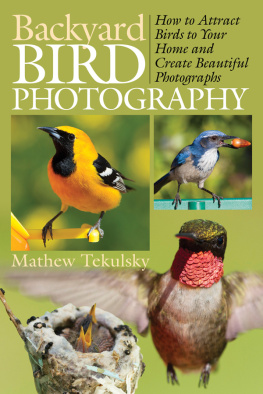Scott Shalaway - Building Backyard Bird Habitat
Here you can read online Scott Shalaway - Building Backyard Bird Habitat full text of the book (entire story) in english for free. Download pdf and epub, get meaning, cover and reviews about this ebook. year: 2000, publisher: Stackpole Books, genre: Romance novel. Description of the work, (preface) as well as reviews are available. Best literature library LitArk.com created for fans of good reading and offers a wide selection of genres:
Romance novel
Science fiction
Adventure
Detective
Science
History
Home and family
Prose
Art
Politics
Computer
Non-fiction
Religion
Business
Children
Humor
Choose a favorite category and find really read worthwhile books. Enjoy immersion in the world of imagination, feel the emotions of the characters or learn something new for yourself, make an fascinating discovery.
- Book:Building Backyard Bird Habitat
- Author:
- Publisher:Stackpole Books
- Genre:
- Year:2000
- Rating:5 / 5
- Favourites:Add to favourites
- Your mark:
- 100
- 1
- 2
- 3
- 4
- 5
Building Backyard Bird Habitat: summary, description and annotation
We offer to read an annotation, description, summary or preface (depends on what the author of the book "Building Backyard Bird Habitat" wrote himself). If you haven't found the necessary information about the book — write in the comments, we will try to find it.
Building Backyard Bird Habitat — read online for free the complete book (whole text) full work
Below is the text of the book, divided by pages. System saving the place of the last page read, allows you to conveniently read the book "Building Backyard Bird Habitat" online for free, without having to search again every time where you left off. Put a bookmark, and you can go to the page where you finished reading at any time.
Font size:
Interval:
Bookmark:
APPENDIX A

SHADE COFFEE
From the courtyard of the hacienda near the tiny village of San Antonio in the southwestern Mexican state of Colima, we set out on foot. One group headed back the paved road toward Comala; the other ambled along a rutted rocky road toward the Laguna El Jabali. By midmorning, my two groups of eager birders had compiled an impressive list of mountain birds. The most spectacular resident species included Mountain Trogons, Masked Tityras, Tufted Flycatchers, Stripe-backed and Red-headed Tanagers, Ivory-billed Wood-creepers, Happy Wrens, Berylline Hummingbirds, and West Mexican Chachalacas. To that list of residents, we added more than a dozen species of Neotropical warblers more commonly seen north of the border. They were winter visitors just like us.
Given the montane setting and the mature forest just beyond the edge of the road, none of these birds came as a surprise. What did surprise me was that the entire area was an active coffee plantation. I didnt expect such terrific birding in the midst of a working farm. The first time I visited San Antonio back in the mid-1980s, I learned firsthand that coffee is a shrub that grows best in the shade of a mature forest canopy. Traditionally, coffee has been grown on forested plantations as a shade-loving crop. Consequently, coffee production and bird conservation complemented each other.
Our studies in the Dominican Republic show that theres no difference between levels of bird survival in shaded coffee plantations and native forests, explains Joseph Wunderle of the International Institute of Tropical Forestry.
It seemed the best of both worlds. Forest birds thrived in the canopy; coffee thrived below. Ecological, economic, and agricultural interests converged in harmony. It seemed too good to be true. It was.
Unbeknownst to me, the dream had begun to unravel into an ecological nightmare in the late 1970s. Major coffee producers discovered that by removing the canopy, coffee grew faster and produced higher yields. Unfortunately, the cost for sun coffees higher productivity, beyond the ecological devastation that accompanied the destruction of the canopy, included expensive fertilizers and pesticides. The switch to sun coffee also led to serious erosion where coffee plantations occupied rugged terrain.
Over the last twenty years, sun coffee has come to dominate the market. Many large coffee growers have switched to new coffee hybrids that produce more beans under full sun. They favor short-term gains and ignore the long-term ecological tolls such as loss of critical habitat for forest birds and dependence upon expensive agri-chemicals. Large coffee plantations led the way because they could afford the expense required to grow sun coffee. Small family growers languished in a shrinking market.
The impact of converting to sun coffee plantations has been ornithologically disastrous. According to a fact sheet published by the Smithsonian Migratory Bird Center, field studies in Mexico and Colombia have found 94 to 97 percent fewer bird species in sun-grown coffee plantations than on shade-grown coffee farms. Furthermore, the amount of land planted in coffee under reduced shade conditions ranges from 17 percent in Mexico to 40 percent in Costa Rica and 69 percent in Colombia.
In recent years, however, entrepreneurs, birders, and small coffee growers formed an enterprising alliance to create both a supply and a demand for bird-friendly, shade-grown coffee. They realize that preserving the forest canopy saves birds.
According to Greg Butcher, former executive director of the American Birding Association (ABA) and now editor of Birders World magazine, There are 60 million bird-watchers in the U.S. If we all demand shade-grown coffee, we can help conserve family farms thatas far as birds are concernedare forests. We believe birders can make a powerful impact on the way coffee is grown... and that shade-grown coffee can help restore migratory songbird habitat in Central America.
The ABA feels so strongly about shade coffee that it has entered into a cooperative program with the California-based Thanksgiving Coffee Company. Paul Katzeff, CEO of Thanksgiving Coffee, was among the first in the coffee business to recognize an unusual opportunity to mix birds and business. In June 1997, Thanksgiving introduced Songbird Coffees, six blends of bird-friendly shade-grown java.
The results exceeded Katzeffs wildest dreams. Songbird Coffee, he reports, is the most successful new product introduction Ive seen in twenty-five years. In just the last half of 1997, Thanksgiving Coffee sold more than 80,000 packages of Songbird Coffees. And for each pound of Songbird Coffee sold, Thanksgiving Coffee Company returns 15 cents to the ABA to support conservation programs. That translated to $12,000 for the ABA in just the first eight months that Songbird Coffees were on the market.
At first, Songbird Coffees were sold only in Wild Birds Unlimited and Wild Oats stores across the country. Slowly, however, Songbird Coffees have begun appearing on shelves in independent bird stores and garden centers. And Butcher suggests that a huge untapped market are the in-house coffee pots at businesses all across the country. It might begin at the editorial offices of bird magazines and conservation organizations, but those 60 million birders could soon have shade coffee brewing in offices and boardrooms everywhere.
Eventually, as understanding of and demand for environmentally friendly brews spill over from the birding public to all who enjoy and appreciate ecological diversity, shade coffees might even appear on the shelves of traditional supermarkets.
Another major player in the shade coffee story is Fred Houk of Counter Culture Coffee in Durham, North Carolina. Counter Culture markets a family of shade coffees under the Sanctuary label. Counter Culture also prepares a shade coffee for the Wild Bird Centers of America stores called Canopy Coffee.
Wild Bird Center COO Jane Crowley says, We launched our Canopy Coffees in September 1997, and they are doing very well. And two of our products were rated first and second in a taste test by Coffee Review Magazine.
A small percentage of the price of both Sanctuary and Canopy Coffees goes to the National Fish and Wildlife Foundation, a private nonprofit conservation group. The NFWF matches each contribution and uses the fund to help Latin American coffee growers improve bird conservation on their properties.
For shade coffee to succeed commercially, however, coffee-drinking bird-ers must be willing to change their buying habits and pay a bit more. They seem more than willing to do both.
The premium price consumers pay for eco-friendly coffee is modest. We can save a lot of forested family farms if people are willing to pay just one penny more per cup, says Daniel Katz, executive director of the Rainfall Alliance, an organization pioneering efforts to certify tropical products from eco-friendly sources. The premium price will give farmers the incentive to stay green, and it will help ensure the survival of some of the earths most cherished birds and wildlife.
Price controls every commodity. If consumers are willing to pay more for a bird-friendly brew, coffee farmers will grow it. By creating a demand, consumers can manipulate the coffee market to once again favor birds.
No matter how environmentally friendly shade coffee may be, though, if it doesnt taste good, no one will buy it. At the Birdwatch America trade show in Atlanta one year, I skulked around Thanksgiving Coffees booth. Staff provided samples to everyone who stopped by, and most were eager to taste the new brew. Over the course of about an hour, I eavesdropped on more than twenty-five conversations. I didnt hear a single bad review, and more than half remarked that the Songbird blend tasted better than their store-bought coffees, which were almost certainly sun coffees. The most impressive testimonial regarding the taste of shade coffee comes from Thanksgiving CEO Katzeff: Of the first 80,000 packages of Songbird Coffees we sold, he said, not a single one came back because a customer was dissatisfied or didnt like the coffee. We got a few returns on defective or torn bags, but not a single complaint about the product itself.
Font size:
Interval:
Bookmark:
Similar books «Building Backyard Bird Habitat»
Look at similar books to Building Backyard Bird Habitat. We have selected literature similar in name and meaning in the hope of providing readers with more options to find new, interesting, not yet read works.
Discussion, reviews of the book Building Backyard Bird Habitat and just readers' own opinions. Leave your comments, write what you think about the work, its meaning or the main characters. Specify what exactly you liked and what you didn't like, and why you think so.








